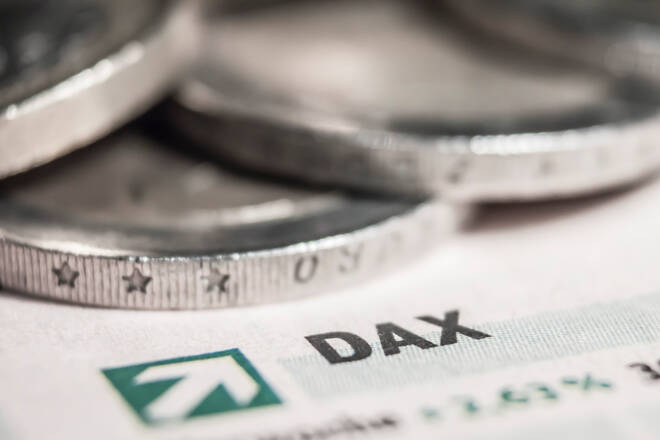Advertisement
Advertisement
European Equities: A Quiet Calendar Leaves the Majors in the Hands of the U.S…
By:
With economic data on the lighter side, the European majors will look to the U.S markets for direction following Thursday's late pullback.
Spanish CPI (YoY) (Aug) Final
Spanish HICP (YoY) (Aug) Final
The Majors
It was a back into the red for the European majors on Thursday. A choppier session than normal left the EuroStoxx600 down by 0.59% to lead the way down.
The DAX30 and CAC40 saw more modest losses of 0.21% and 0.38% respectively.
For the European majors, a gloomier economic outlook from the ECB weighed, in spite of an upward revision to growth forecasts.
While upwardly revising its GDP projection from an 8.7% contraction to an 8% contraction for 2020, the ECB noted that the recovery would likely be a slower one.
The Bank also noted that inflation will likely fall short of the ECB’s target for the foreseeable future. For the majors, the EUR’s brief return to $1.19 levels would not have helped.
On the economic data front, U.S jobless claims figures failed to impress adding to the market angst.
The Stats
It was a particularly quiet day on the Eurozone economic calendar. There were no material stats to provide the majors with direction on Thursday.
While there were no stats to consider, the ECB’s monetary policy and press conference were of influence.
The ECB left monetary policy unchanged, which was in line with expectations that had provided some early support to the EUR.
By contrast, the European majors struggled ahead of the policy decision. A sharp pickup in the EUR and uncertainty over the ECB’s economic outlook contributed to the downside.
Key comments from the Lagarde press conference included:
- Euro-area domestic demand has rebounded strongly, though heightened economic uncertainty persists. This uncertainty continues to weigh on both business investments and consumer spending.
- The ECB sees the economy contracting by 8.0% for 2020, revised up from 8.7%. For 2021, the economy is projected to contract by 5% and then by 3.2% in 2022.
- EUR strength was discussed but from a price pressure perspective. The ECB looks for price stability rather than directly targeting currency exchange rates.
- EUR appreciation delivers negative price pressures. Such an eventuality would require a move by the ECB to ease any negative price pressures.
- Members discussed the current policy framework but would not make any changes.
- The ECB will use all tools available to deliver price stability.
- Divergence is seen across the EU, with fiscal space, fiscal position, and banking strength creating the divergence. The ECB expects the EU Recovery Fund to address this divergence. The flexibility of the ECB’s PEP is also there to address divergence.
From the U.S
Economic data was on the lighter side once more. August wholesale inflation figures and the weekly jobless claims were in focus.
The stats coincided with the ECB press conference, contributing to the spike in the EUR.
In the week ending 4th September, U.S initial jobless claims stood at 884k, which was worse than a forecasted 846k. In the week prior, claims had also stood at 884k.
Inflation numbers were also disappointing, with the producer price index rising by just 0.3% in August. While better than a forecasted 0.2% rise, the index had risen by 0.6% in July. The core producer price index rose by 0.4% following a 0.5% rise in July. Economists had also forecast a 0.2% rise.
The Market Movers
For the DAX: It was a mixed day for the auto sector on Thursday. Continental rose by 0.45% to buck the trend on the day, while BMW slid by 1.60%. Daimler and Volkswagen saw more modest losses of 0.82% and 0.89% respectively.
It was also a mixed day for the banks. Deutsche Bank fell by 0.98%, while Commerzbank rose by 0.83%.
From the CAC, it was a bullish day for the banks. BNP Paribas and Soc Gen saw gains of 0.58% and 0.55% respectively. Credit Agricole trailed, with a 0.32% rise on the day.
It was yet another mixed day for the French auto sector. Peugeot ended the day up by 3.13%, while Renault slid by 1.46%.
Air France-KLM ended the day down by 0.08%, while Airbus SE eked out a 0.07% gain.
On the VIX Index
It was back into the green for the VIX on Thursday. Partially reversing an 8.42% fall from Wednesday, the VIX rose by 3.12% to end the day at 29.71.
It was a bearish day for the U.S majors that coughed up early gains as the tech recovery faltered on the day.
The NASDAQ slid by 1.99%, with the Dow and S&P500 ending the day down by 1.45% and by 1.76% respectively.
The Day Ahead
It’s a relatively quiet day ahead on the Eurozone economic calendar. Key stats include August’s finalized inflation figures for Germany and Spain.
Barring downward revisions, we don’t expect the stats to influence. The markets had already responded to disappointing inflation numbers last week.
From the U.S, August inflation figures are due out and will influence.
With economic data on the lighter side, we can expect the European majors to continue to take their cues from the U.S. markets late in the day.
On the geopolitical front, there are also Brexit and U.S-China tensions to also consider on the day.
The Futures
In the futures markets, at the time of writing, the Dow was up by 59 points.
For a look at all of today’s economic events, check out our economic calendar.
About the Author
Bob Masonauthor
With over 20 years of experience in the finance industry, Bob has been managing regional teams across Europe and Asia and focusing on analytics across both corporate and financial institutions. Currently he is covering developments relating to the financial markets, including currencies, commodities, alternative asset classes, and global equities.
Did you find this article useful?
Latest news and analysis
Advertisement
